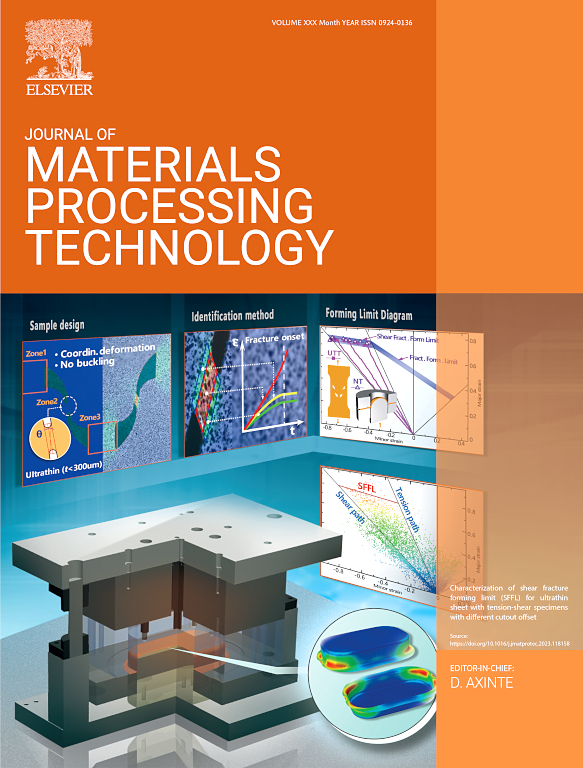Enhancing formability via reciprocating counter-roller spinning: Dynamic coordination of complex flexible return path
IF 7.5
2区 材料科学
Q1 ENGINEERING, INDUSTRIAL
Journal of Materials Processing Technology
Pub Date : 2025-07-16
DOI:10.1016/j.jmatprotec.2025.118988
引用次数: 0
Abstract
To address the inherent trade-off between high performance and insufficient precision in the conventional counter-roller spinning (CRS) process, a novel reciprocating counter-roller spinning (RCRS) methodology is proposed, featuring coordinated control between the working path and a complex flexible return path. Crucially, the return stroke is transformed from an idle movement into a "dynamic compensation path" with active error-correction capability, fully leveraging the trajectory flexibility inherent in CRS to achieve path-level dynamic correction of forming errors. To realize this, a flexible return path optimization model based on ideal shape discrepancy compensation is established. A multi-objective optimization framework correlating the compensation coefficient k with geometric accuracy is developed. The optimal path design is achieved using the non-dominated sorting genetic algorithm (NSGA-II) on a Kriging surrogate model. Furthermore, an adaptive return path interpolation program is developed by integrating MATLAB and Mastercam, ultimately enabling the high-quality integrated forming of geometric precision and mechanical properties in cylindrical workpieces. Simulation and experimental results demonstrate significant improvements: The average straightness L and maximum outer generatrix contour deviation ΔDR of formed parts are remarkably enhanced from the 10⁻¹ to the 10⁻² level, representing improvement rates of 71.38 % and 77.37 %, respectively. This effectively resolves the "precision bottleneck" of CRS. Although localized stress state changes occurred in the "inner concave" correction zone due to intensified material flow, the overall forming performance showed a clear enhancement over the original blank. Microstructural analysis further revealed a uniform {001}< 100 > texture and η-fiber structure. The primary strengthening mechanism is identified as dislocation multiplication and entanglement induced by geometrically necessary dislocation density ρGND. These results provide verifiable theoretical mechanisms and a key technical pathway for promoting the application of highly flexible CRS in high-precision manufacturing.
通过往复反罗拉旋压提高成形性:复杂柔性回程路径的动态协调
针对传统反罗拉纺丝工艺中存在的性能高、精度差的问题,提出了一种基于工作路径与复杂柔性返回路径协调控制的往复反罗拉纺丝方法。最关键的是,将回行程从空闲运动转化为具有主动纠错能力的“动态补偿路径”,充分利用CRS固有的轨迹灵活性,实现路径级的成形误差动态纠错。为此,建立了基于理想形状差异补偿的柔性返程路径优化模型。建立了补偿系数k与几何精度相关的多目标优化框架。在Kriging代理模型上,采用非支配排序遗传算法(NSGA-II)实现最优路径设计。在此基础上,结合MATLAB和Mastercam开发了自适应返回路径插补程序,实现了圆柱形工件几何精度和力学性能的高质量集成成形。模拟和实验结果表明:成形零件的平均直线度L和最大外母线轮廓偏差ΔDR从10⁻¹ 到10⁻²水平有了显著的提高,分别提高了71.38 %和77.37 %。这有效地解决了CRS的“精度瓶颈”。虽然由于材料流动加剧,“内凹”修正区出现了局部应力状态变化,但整体成形性能较原坯料有明显提高。显微组织分析进一步揭示了均匀的{001}<; 100 >; 织构和η纤维组织。几何必要位错密度ρGND引起的位错倍增和纠缠是主要的强化机制。这些结果为推进高柔性CRS在高精度制造中的应用提供了可验证的理论机制和关键的技术途径。
本文章由计算机程序翻译,如有差异,请以英文原文为准。
求助全文
约1分钟内获得全文
求助全文
来源期刊

Journal of Materials Processing Technology
工程技术-材料科学:综合
CiteScore
12.60
自引率
4.80%
发文量
403
审稿时长
29 days
期刊介绍:
The Journal of Materials Processing Technology covers the processing techniques used in manufacturing components from metals and other materials. The journal aims to publish full research papers of original, significant and rigorous work and so to contribute to increased production efficiency and improved component performance.
Areas of interest to the journal include:
• Casting, forming and machining
• Additive processing and joining technologies
• The evolution of material properties under the specific conditions met in manufacturing processes
• Surface engineering when it relates specifically to a manufacturing process
• Design and behavior of equipment and tools.
 求助内容:
求助内容: 应助结果提醒方式:
应助结果提醒方式:


